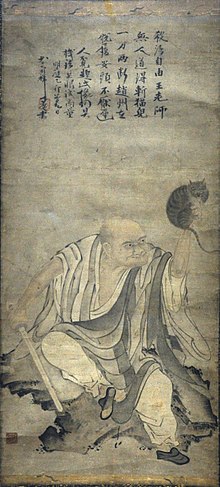Nanquan Puyuan
Nanquan Puyuan | |
|---|---|
 Case #14 of The Gateless Gate: "Nansen kills the cat" | |
| Personal | |
| Born | c. 749 |
| Died | c. 835 |
| School | Hongzhou school |
| Senior posting | |
| Teacher | Mazu Daoyi |
| Predecessor | Mazu Daoyi |
| Successor | Zhaozhou Congshen |
Nanquan Puyuan (Chinese: 南泉普願; Wade-Giles: Nan-ch’üan P’u-yüan; Pinyin: Nánquán Pǔyuàn; Japanese: Nansen Fugan) (c. 749 – c. 835) was a Chán (Zen) Buddhist master in China during the Tang Dynasty.[1] He was the student and Dharma successor of the Master Mazu Daoyi (709-788).
Biography
In the year 795, after his enlightenment experience under Mǎzŭ, he settled in a self-made hut on Mount Nanquan, from which his dharma name is derived, and lived there in eremitic solitude for three decades.[2] In time, monks persuaded him to come down the mountain and found a monastery; from that time forward, he always had hundreds of students.[3]
Appearance in koans
Nanquan appears in several koans:
- 4 koans in The Gateless Gate (#14, #19, #27, #34),
- 6 koans in the Blue Cliff Record (#28, #31, #40, #63, #64, #69), and
- 3 koans in The Book of Serenity (#9, #69, #91).
Two koans from the Blue Cliff Record (#28 & #69) depict Nanquan as an advanced student interacting with fellow students of Mǎzŭ, and the others depict him as a teacher in his own right.
A well-known koan is case #14 of the Gateless Gate, "Nansen kills the cat":
Once the monks of the eastern and western Zen halls were quarrelling about a cat. Nansen held up the cat and said, "You monks! If one of you can say a word, I will spare the cat. If you can't say anything, I will put it to the sword." No one could answer, so Nansen finally slew it. In the evening, when Joshu returned, Nansen told him what had happened. Joshu, thereupon, took off his sandals, put them on his head and walked off. Nansen said, "If you had been there, I could have spared the cat."[4]
Influence
Nánquán had seventeen Dharma successors, the most famous of whom was Zhàozhōu Cōngshěn (778-897).[5] Case #19 of the Gateless Gate recounts an interaction between Nánquán and Zhàozhōu that led to the latter having a profound realization; some translators/editors, for example Paul Reps, interpret this as Zhàozhōu’s enlightenment moment.[6]
References
- ^ Fung Yu-lan, A History of Chinese Philosophy, vol. II, p. 397n2 states that his dates are 'variously given as 745-831, 748-834, 749-835, and 752-838.'
- ^ The Shambhala Dictionary of Buddhism and Zen, p. 154
- ^ The Shambhala Dictionary of Buddhism and Zen, p. 154
- ^ Nansen Kills the Cat (The Gateless Gate, Case 14; translated by Koun Yamada. Center Publications 1979)
- ^ The Shambhala Dictionary of Buddhism and Zen, p. 154
- ^ Reps, Paul. Zen Flesh, Zen Bones, 1989, p. 105
